

Immigration Minister releases Population Report. Illustration: Robin Cowcher The issue of population has been a contentious one as Australians have heard one leader extol the virtues of a "big Australia" (Kevin Rudd), while his successor, Julia Gillard, shrank from the term and added sustainability to the population minister's portfolio.
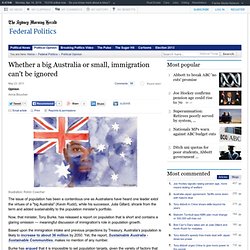
Now, that minister, Tony Burke, has released a report on population that is short and contains a glaring omission — meaningful discussion of immigration's role in population growth. Based upon the immigration intake and previous projections by Treasury, Australia's population is likely to increase to about 36 million by 2050. Yet, the report, Sustainable Australia - Sustainable Communities, makes no mention of any number. Burke has argued that it is impossible to set population targets, given the variety of factors that can inform population growth.
Advertisement The report avoids discussion of immigration, most likely because of the political sensitivities around the issue. A Sustainable Population Strategy for Australia - Issues Paper. This Sustainable Population Strategy outlines the Government’s framework for a sustainable Australia.
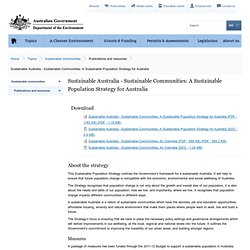
It will help to ensure that future population change is compatible with the economic, environmental and social wellbeing of Australia. The Strategy recognises that population change is not only about the growth and overall size of our population, it is also about the needs and skills of our population, how we live, and importantly, where we live. It recognises that population change impacts different communities in different ways. A sustainable Australia is a nation of sustainable communities which have the services, job and education opportunities, affordable housing, amenity and natural environment that make them places where people want to work, live and build a future.
Measures. Sustainable Population Strategy for Australia - Home Page. Sustainable Population Strategy releasedSustainable Australia Sustainable Communities - A Sustainable Population Strategy for Australia was released on Friday 13 May 2011.
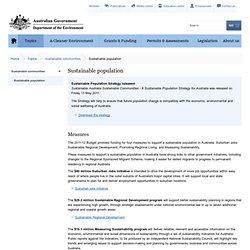
The Strategy will help to ensure that future population change is compatible with the economic, environmental and social wellbeing of Australia. Download the strategy Measures The 2011-12 Budget provided funding for four measures to support a sustainable population in Australia: Suburban Jobs; Sustainable Regional Development; Promoting Regional Living; and Measuring Sustainability. These measures to support a sustainable population in Australia have strong links to other government initiatives, including changes to the Regional Sponsored Migrant Scheme, making it easier for skilled migrants to progress to permanent residency in regional Australia.
Suburban jobs initiative. Big Australia: how big, why and where will we live. Dick Smith Population Puzzle AGAINST. Dick Smith Population Puzzle. Big Australia vision goes down like a lead balloon. Is immigration such a good idea?
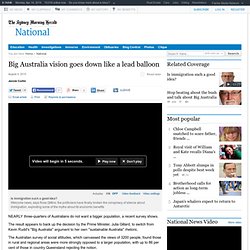
Welcome news, says Ross Gittins: the politicians have finally broken the conspiracy of silence about immigration, exploding some of the myths about its economic benefits 3, 2010 NEARLY three-quarters of Australians do not want a bigger population, a recent survey shows. The result appears to back up the decision by the Prime Minister, Julia Gillard, to switch from Kevin Rudd's ''Big Australia'' argument to her own ''sustainable Australia'' rhetoric. The Australian survey of social attitudes, which canvassed the views of 3200 people, found those in rural and regional areas were more strongly opposed to a larger population, with up to 86 per cent of those in country Queensland rejecting the notion.
NSW inner-city residents held more moderate views than the population as a whole, with 58 per cent saying ''no'' and 42 per cent ''yes'' to more people, compared with a 72 per cent rejection rate overall. Advertisement. Australia 2050 - The Book. Australia 2050 Big Australia THE BOOK PDF. Big Australia Presentation Brian Haratsis PDF. Brian Haratsis. The population debate: do you want 'a big Australia'? Updated Sun 31 Jan 2010, 12:56pm AEDT 35 million Australians by 2050.
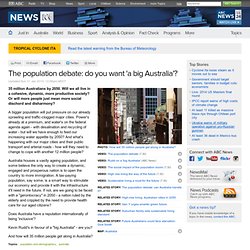
Will we all live in a cohesive, dynamic, more productive society? Or will more people just mean more social dischord and disharmony? A bigger population will put pressure on our already sprawling and traffic-clogged major cities. Power's already at a premium, and water's on the federal agenda again - with desalination and recycling of water - but will we have enough to feed our increasing water appetite by 2050? Numbers don't add up in big and small debate. Numbers need attention in 'big Australia' debate. IF WE'RE going to have a great debate about whether we want a ''big Australia'', people will need a much stronger grasp of the factors driving population growth and immigration than they've shown so far.
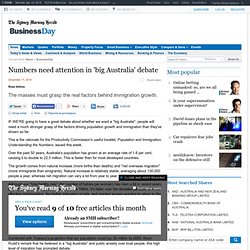
This is the rationale for the Productivity Commission's useful booklet, Population and Immigration: Understanding the Numbers, issued this week. Over the past 50 years, Australia's population has grown at an average rate of 1.6 per cent, causing it to double to 22.3 million. This is faster than for most developed countries. The growth comes from natural increase (more births than deaths) and ''net overseas migration'' (more immigrants than emigrants). Natural increase is relatively stable, averaging about 130,000 people a year, whereas net migration can vary a lot from year to year. Advertisement Although our ''total fertility rate'' (the number of babies per woman) has risen a bit in recent years, it's only about half the peak it reached in the 1960s. Business takes aim at 'big Australia' debate.
DESCRIBING a population of 36 million by 2050 as "big Australia" is unhelpful to the debate on the nation's future and fosters community unease, the Business Council of Australia will warn today.
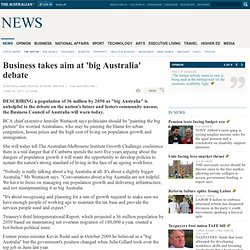
BCA chief executive Jennifer Westacott says politicians should be "painting the big picture" for worried Australians, who may be pinning the blame for urban congestion, house prices and the high cost of living on population growth and immigration. Big Australia back on the agenda, says Craig Emerson. Trade Minister Craig Emerson insists Australia must boost immigration levels.
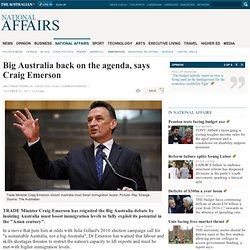
Picture: Ray Strange Source: The Australian TRADE Minister Craig Emerson has reignited the Big Australia debate by insisting Australia must boost immigration levels to fully exploit its potential in the "Asian century". In a move that puts him at odds with Julia Gillard's 2010 election campaign call for "a sustainable Australia, not a big Australia", Dr Emerson has warned that labour and skills shortages threaten to restrict the nation's capacity to lift exports and must be met with higher immigration levels. The minister's warning came yesterday in an economic position paper designed to spark public debate about the need for what Dr Emerson describes as a "third phase" of economic reform to boost national productivity.
Dr Emerson, a former adviser to Bob Hawke, has emerged in recent months as a strong defender of Ms Gillard's leadership and a proponent for greater focus on economic reform. Ideas@TheCentre - State the obvious in the big Australia debate. Oliver Marc Hartwich | Newcastle Herald | 07 October 2010 A week is a long time in politics, and one and half months feels like an eternity.
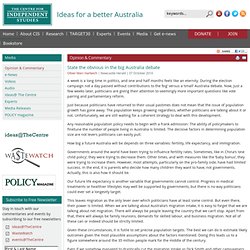
During the election campaign not a day passed without contributions to the ‘big’ versus a ‘small’ Australia debate. Now, just a few weeks later, politicians are giving their attention to seemingly more important questions like vote pairing and parliamentary reform. Just because politicians have returned to their usual pastimes does not mean that the issue of population growth has gone away. The population keeps growing regardless, whether politicians are talking about it or not. Any reasonable population policy needs to begin with a frank admission: The ability of policymakers to finetune the number of people living in Australia is limited. How big a future Australia will be depends on three variables: fertility, life expectancy, and immigration. Governments around the world have been trying to influence fertility rates.